The Top 10 Emmy Nominees for Outstanding Production Design
The dystopian city of Gilead, a period-perfect ’50s-style Catskills resort, the Manhattan co-op of an interior designer and her best friend/partner, and a musical-themed sketch based on a bodega are just a few of Emmy-nominated sets vying for Outstanding Production Design at this year’s 71st Primetime Emmy Awards ceremony.
The competition is varied with perennial favorites such as The Handmaid’s Tale and The Marvelous Mrs. Maisel, while we bid adieu to Game of Thrones (a record 32 nominations) and Veep (nine nominations) as those series come to a close. The stylish apartments of Man in the High Castle and the Broadway scenery of Fosse/Verdon also caught our eye.
Tune in to see the Primetime Creative Arts Emmy Awards on Saturday, September 21, and see which talented production designer, art director, or set decorator adds an Emmy to their mantel. (Award junkies take note as production design, guest actor in a series, and costumes are awarded on this night.) The main show airs on Sunday, September 22.
Here is the outstanding work from a few of AD's favorite shows:
Chernobyl
HBO
Luke Hull, Production Designer
Karen Wakefield, Art Director
Claire Levinson-Gendler, Set Decorator
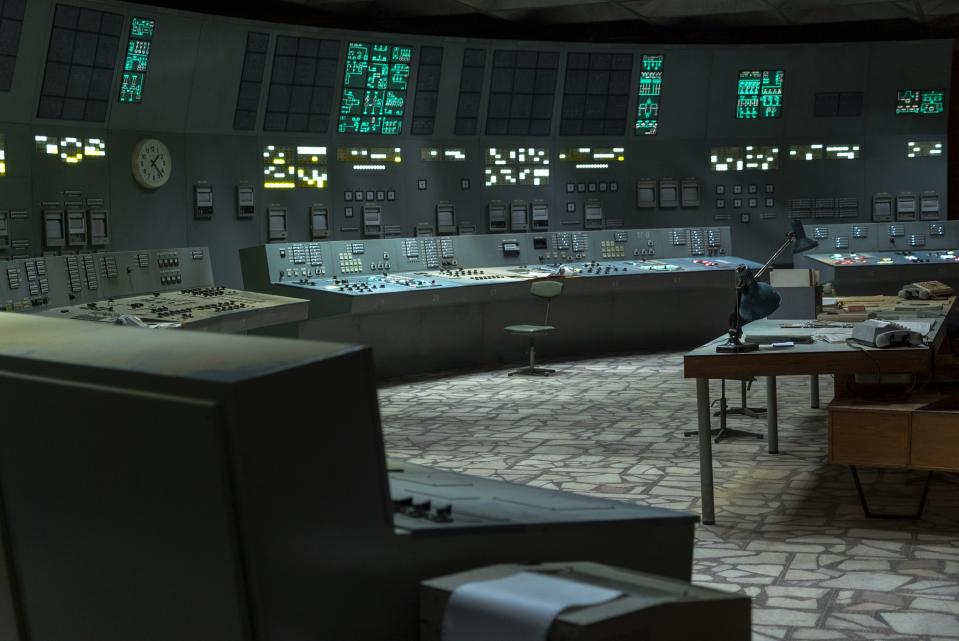
When telling the story of an international nuclear incident such as the 1986 environmental catastrophe known as Chernobyl, production designer Luke Hull re-created a nuclear facility and reactor along with a neighboring town in period-perfect detail. Filming in Lithuania and Ukraine, the designer spent a year on the project, beginning with historical research that included “a great number of first-person accounts, which helped bring an additional layer of authenticity and humanity to the story,” he says. “To find out what happened, I looked at a few good photo books and YouTube videos on how people were living in their apartments, going on about her lives, and the acts of bravery.” Hull and his team also looked at a similarly designed decommissioned nuclear plant in Kursk and constructed a 3D model to use as a guideline, while a backlot in Lithuania served as the shell and interior of the building that housed the reactor, with the help of CGI.
The designer also captured the ambiance of 1980s Soviet Union (particularly the nearby town of Pripyat that was the home of the plant and the fire workers) through architecture, design, and color, often running into problems with clearances when it came to props. “For the color palette, I used clear sinister tones,” explains Hull. “We were dealing with radiation, so the color orange pops up from time to time.” As a result, many things had to be made, such as a bust of Vladimir Lenin, along with scientific equipment and radiological gear. The crew was not able to use maps, newspapers, and artwork from the time but did scour flea markets and eBay for clothing and remnants of the past such as ashtrays, lamps, and housewares. And in a note of irony, Hull and his team did find an American reference located outside an abandoned convenience store in the form of a statue of Mickey Mouse.
Fosse/Verdon
FX Networks
Alex DiGerlando, Production Designer
Anu Schwartz, Supervising Art Director
Lydia Marks, Set Decorator

For the Broadway, television, and film world of director Bob Fosse and his wife, the actress, dancer, and choreographer Gwen Verdon, in FX’s Fosse/Verdon, production designer Alex DiGerlando and set decorator Lydia Marks were fortunate to have their daughter Nicole Fosse as an adviser, as authenticity was paramount. Says set decorator Lydia Marks, “We had amazing access to Verdon’s and Fosse’s private life and worked with the Fosse-Verdon legacy. We looked at materials in the Library of Congress, newspapers, movies, stage sets, and still photos of NYC in that era. The most important things were the family stories that Nicole Fosse brought us.”
Audiences were treated to snippets of Fosse’s greatest works that were re-created in a single rehearsal hall at New York’s Silvercup Studios and constantly changed according to the show and details (columns, ceiling, lighting, etc.). The New Haven, Connecticut, tryout set for Damn Yankees, the Fandango ballroom from Sweet Charity, the Kit Kat room from Cabaret, and the “Bye Bye” scene from All That Jazz were a walk down memory lane for the avid theatergoer. “When re-creating such iconic productions like Cabaret, we all felt we had to be 100% authentic,” says Marks. “So many people know what the ‘Mein Herr’ set in Cabaret looks like, so every single detail had to be perfect. I eventually had furniture makers produce Liza Minnelli’s chair for that number because we needed it to be right.” And for the Chicago sets, DiGerlando looked to the legendary set designer Tony Walton, who, fortunately, had renderings from the original show. He also looked to the Fosse’s biopic of All That Jazz as reference for particular scenes (such as the Mylar-curtained set seen in the ”Bye Bye” finale). “We approached it as the fantastical version of his life the way he saw it and wanted to be perceived by people, but we tried not to lean on it too much,” Marks adds.
One of the key sets was the Manhattan apartments that included the faithful re-creations of Fosse’s bachelor pad on 58th Street. As DiGerlando describes, “It was a very sad run-of-the-mill bachelor pad and very lonely and not as aspirational an apartment you would imagine a multi–Oscar, Tony, and Emmy award winner living in.” The Central Park West co-op apartment Fosse shared with Verdon (rumored to be designed for William Randolph Hearst as a rendezvous spot with Marion Davis, it is now owned by Giorgio Armani) was built on a soundstage. The designers reconstructed the apartment’s gothic details, stained glass, cherubs, Old Master paintings, and even the crunched orange velvet wall coverings.
Game of Thrones
HBO
Deborah Riley, Production Designer
Paul Ghirardani, Art Director
Rob Cameron, Set Decorator
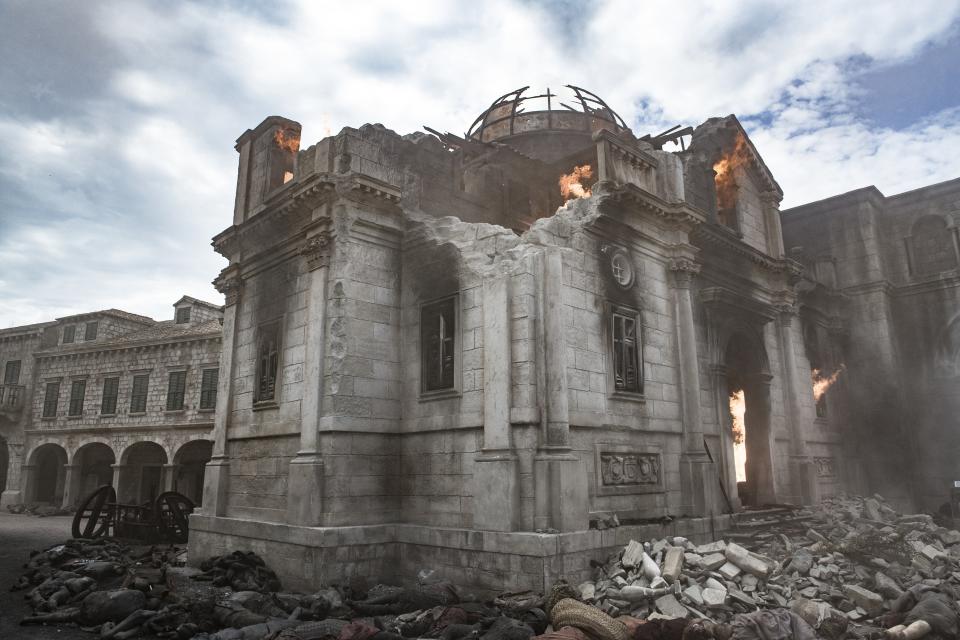
The gargantuan task—and that is an understatement—of creating the fantastical new worlds or kingdoms of the epic phenomena that is Game of Thrones fell to Australian production designer Deborah Riley. For the final season, the four-time Emmy winner (this year marks her fifth nomination) designed the majestic final battle sets for control of the Iron Throne and the subsequent assault on King’s Landing in “The Bells.”
“King’s Landing had historically been shot in Dubrovnik, Croatia, but because of the destruction of the set in the fifth episode of Season 8, for the first time we had to build King’s Landing for ourselves,” says Riley. Eventually constructing it in Belfast, the design team faced numerous hurdles from creating an outdoor set in the Northern Irish winter to the overall destruction of the King’s Landing set. “It was decided that we would build the set in its destructed phase first and then clad it with the pristine version of the set. By doing this, we were able to film it as the city first as we would have seen it in Dubrovnik and then convert it to the destructed phase by stripping away the front layer of finished set, thereby revealing the destruction.”
Action sequences and special effects also came into play. “We needed big City Gates, both perfect and blown, a Main Street, perfect, then within the firestorm and later completely devastated, a City Plaza, perfect and in the firestorm, two other streets, an entrance to the Red Keep, and the alleys of Fleabottom for Arya to run through and many other side alleys off the streets,” explains the designer.
And, of course, there was the aftermath of the dragon’s terror. “Dubrovnik was our design base, but from that we needed to imagine what it would look like during battle, the firestorm, and how to depict the aftermath of the dragon strafes,” says Riley. “The London Blitz was the main reference point.”
Will & Grace
NBC
Glenda Rovello, Production Designer
Conny Marinos, Art Director
Peter Gurski, Set Decorator
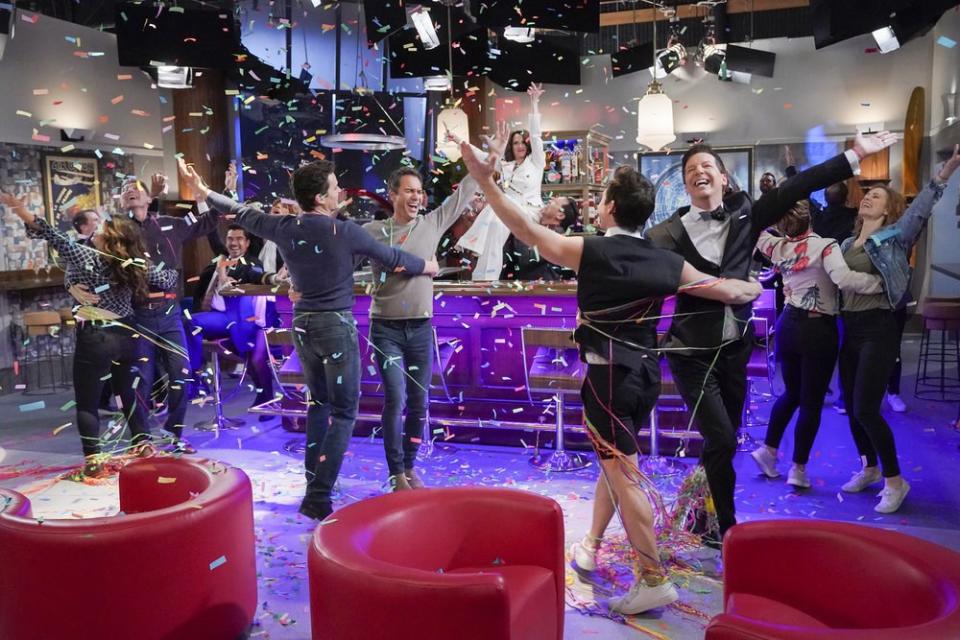
Will & Grace - Season 2
The beloved quartet of BFFs—Will, Grace, Jack, and Karen—have been a mainstay in our living rooms since Will & Grace first aired in 1998. Following an 11-year hiatus, the show returned for its ninth season with the iconic Manhattan apartment intact, albeit with a few changes. The show’s original production designer, Glenda Rovello, and set decorator, Peter Gurski, reconstructed the original set, which includes the apartment and Grace Adler Designs. Gurski notes, “Fortunately, we had everything from the original set because it had been on display at Emerson College for about 10 years.” The designers were careful to keep the overall aesthetic intact so viewers would recognize the sets, particularly the proportions and furniture placement.
Nominated for the episode “Jack’s Big Gay Wedding,” where Jack and his fiancé are stranded at the airport on their way to the altar, Rovello details, “The challenge was how to make the airport large enough to accommodate the soundstage. It’s always about size and scale and to be able to tell a big enough story, so that the sets pass muster on camera. This translates to creating long sight lines along with convincing materials. We even had a courtesy golf cart going up and down the set—that’s how big it was!”
As a result, the permanent sets had to be taken out overnight and the airport set created the next day. Gurski fully dressed the airport with furniture, lighting, and a full souvenir shop with newly manufactured items or ones bought and cleared through the legal department.
Saturday Night Live
NBC
Eugene Lee, Production Designer
Akira Yoshimura, Production Designer
Keith Ian Raywood, Production Designer
Joseph De Tullio, Production Designer
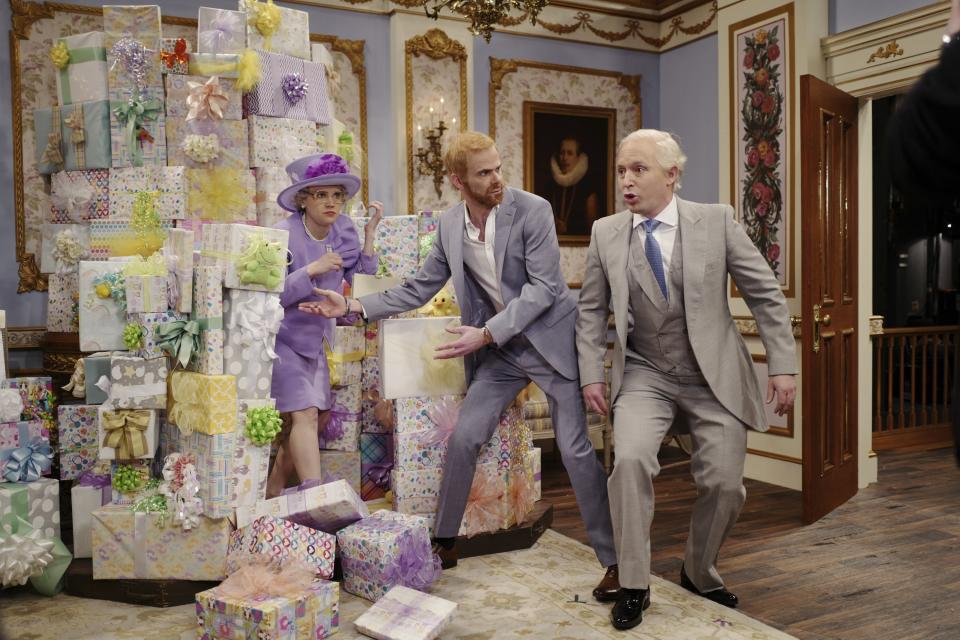
Saturday Night Live - Season 44
Designing the iconic late-night world of Saturday Night Live (45 years and counting) represents its own challenges, as expediency, adaptability to change, and the unknown are the order of the day. Tasked for the overall look of the show is 78-year-old production designer Eugene Lee, who has been with SNL for 42 seasons and 500 episodes.
For the Emmy-nominated episode with guest host John Mulaney, a musically themed sketch that takes place in a New York City bodega (complete with a bodega cat, talking cockroaches, and dancing Virgin Mary candles) was one of the highlights. As set designer Keith Ian Raywood describes, “The bodega had two sets built into one: the front of the store and the out-scale bodega bathroom behind the front of the store with the out-scale bodega bathroom behind. The reveal was accomplished on camera with two automated turntables.” Set designer Joseph De Tullio also noted, “Not to go unnoticed, a final piece of the puzzle was the additional work by the Money Boys specialty prop makers; they were hired to make some gag props and a lightweight talking toilet.”
The turntables also did double duty in another Emmy-nominated show, with Emma Stone as host and a sketch of a over-the-top party for the royal newborn of the Duke and Duchess of Sussex, a.k.a. Prince Harry and Meghan Markle. “We used a turntable to make it appear that Harry goes in a set of doors between two rooms. He, in fact, exited through doors that then rotated 180 degrees and entered in the same room, which had been quickly re-propped to look like another room,” says Raywood. For the palace interiors, DeTullio credits the ease of the internet, citing, “Due to research and access to the internet nowadays, it was a duplication of an existing room in the palace. In this case, things like architecture, color, and furniture are simply matched to the best of our ability from our research.”
The Oscars
ABC
David Korins, Production Designer
Alana Billingsley, Art Director
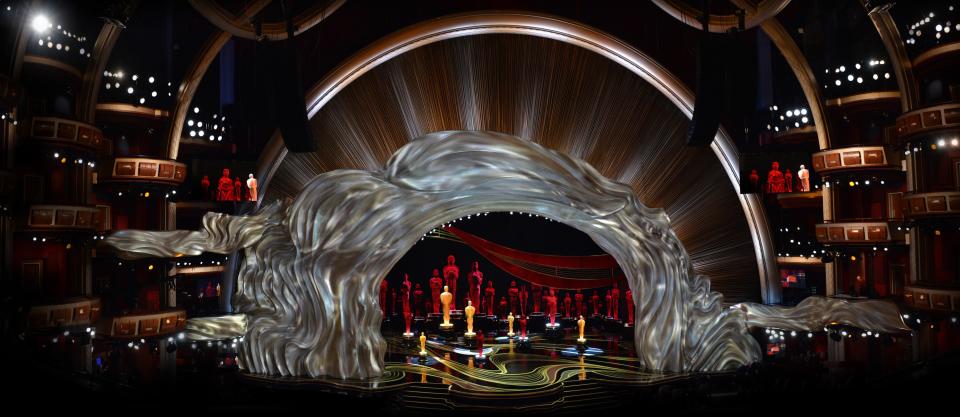
A Crystal Cloud formation of thousands of hand-strung beads and an architecturally spiral and twisted shaped Crystal Swag—all made by Swarovski—were two of the major design motifs created by production designer extraordinaire David Korins.
No stranger to theatrical set design, Korins is best known for his Tony-nominated work on Hamilton, Beetlejuice, and War Paint, just to name a few. For his initial research, he notes, “I didn’t look back at all at the previous Oscar sets, and with the format changing I realize there are a lot of pressures on the design that didn’t exist years ago. Typically, I don’t look back and try to really look forward.” Referencing the Venn diagram of how people relate to the movie industry, Korins details, “We only get one shot, one three-hour block of time to really represent what the show is and what we see, and the visions of the world, so I really thought I could deliver one massive kind of multimillion communal experience—that was my opportunity for a narrative and what I through the audience wanted to see.”
Choosing flowers and organic shapes that he had never seen live on the telecast, his goal was to go with a “warm, feminine elegance” and make the architecture literally mimic a cloud form through the use of the crystals. The overall effect took 40,000 roses and 50,000 Swarovkski crystals as the designer notes, “Swarvoski is synonymous with the Oscars. They have a long history together.”
Designing the Oscar set is not for the faint of heart. “The Dolby Theater becomes the center of the world, and I had no idea who crazy it gets,” he reflects. “Every single day the landscape changes. It made the Tonys seem like a backyard barbecue!”
The Man in the High Castle
Prime Video
Drew Boughton, Production Designer
Dean O’Dell, Art Director
Jonathan Lancaster and Lisa Lancaster, Set Decorators

Imagine a world where Nazi Germany and Imperial Japan take over the United States after World War II, and you have the setting for Prime Video’s best-selling book turned TV series The Man in the High Castle. With his Manhattan set, the Emmy-nominated production designer Drew Boughton (this marks his third nomination for the series) created a fictional universe that divides America into German, Japanese, and neutral zones with designs influenced by Eastern Bloc modernism and Soviet-era interiors and buildings,
Standout sets in Season Three include a lavish Manhattan apartment for a high-ranking Nazi leader. Designed in a sort of alternative modernism from the ground up, he and set decorators Jonathan and Lisa Lancaster incorporated Art Deco, classical, and neoclassical design elements. “This gave us a chance to build a new penthouse apartment set that has a unique alternative history and midcentury modern–bastard style, and involved mixing Germanic Biedermeier furniture styles and finishes with Albert Speer’s relentless rectangularity and American modernism,” says the designer.
The Denver Palace set is also of interest, as Boughton notes, “It is like “Rick’s Café in the film Casablanca, a palace of danger and joy in a Wild West–like crossroads, an aging Beaux Arts setting representing America’s fading memory.”
The Marvelous Mrs. Maisel
Prime Video
Bill Groom, Production Designer
Neil Prince, Art Director
Ellen Christiansen, Set Decorator

A 1950s-style Upper West Side of Manhattan apartment and a quintessential lakeside resort in the Catskills make up the Emmy nominated designs for “Simone, We’re Going to the Catskills,” from the second season of the hit show The Marvelous Mrs. Maisel.
For a summer in the Borscht Belt, veteran production designer Bill Groom and set decorator Ellen Christiansen located a large hotel with a lake in upstate New York’s Catskills that was owned by a family for generations since 1860. “The challenge in decorating the Catskills was to make it fresh for the 1950s while being true to the longer history of the place,” says Christiansen. She looked at the family’s old photos and postcards as reference for clues to the time period, resulting in a mix of 1950s modern and classic Colonial with antique wicker and Old Hickory twig-style furniture. “We sourced period-appropriate fabric and reupholstered several vintage chairs and settees that belonged to the resort.” And fun fact: Rumor has it the family turned down the producers of Dirty Dancing, who wanted to film there.
The pair also created over 60 sets for the show including the “classic six” Upper West Side family apartment, the Gaslight night club, and B. Altman’s department store, which were primarily shot at Brooklyn’s Steiner Studios.
The Handmaid’s Tale
Hulu
Elisabeth Williams, Production Designer
Martha Sparrow, Art Director
Robert Hepburn, Set Decorator

Bear Witness
Harrowing, horrific, and hellacious do not begin to describe the dystopian world of oppression in the third season of Hulu’s The Handmaid’s Tale. Set in fictional Gilead (a.k.a. Boston via Toronto), highlights of the season included the new environs of Washington, D.C. Shooting on location at the Lincoln Memorial and Washington Monument proved to be chilling, as the CGI-enhanced image of a shattered Lincoln statue and the obelisk-style monument turned into a cross are a shock to the audience.
Production designer Elisabeth Williams (whose work on the past 26 episodes garnered her two Emmy noms and one win) created new sets, such as the hospital, Commander Lawrence’s mansion, hotel rooms, and a Gilead amphitheater, while sets for Jezebel’s and the pristine stark mansions of Gilead make a return. “D.C. is Gilead on steroids,” says Williams. “When we shot in D.C. on the steps of the Lincoln Memorial, we had about 200 handmaids on the ground with flags, and added the extra with CGI.” For research, the designer looked to the original book as well as “visual research from Nazi Germany, North Korea, and the USSR. I compiled images and used red, black, and gold flags that are visual symbols (of these countries) that tell a story we all recognize.” This is contrasted with the cluttered and lived-in looks of the embassy and Luke’s apartment sets in Toronto’s fictitious Little America.
The overall effect is one of “anxiety designs,” as the Canadian designer says, “I find the use of color repetition to be fear-inducing, such as the repetition of the flags along with stripping way any excess that doesn’t have a specific purpose. That which is futile and unnecessary disappears, and that in itself is chilling.”
The designer found continuity to be problematic as well. “Keeping our world separate visually was difficult as we shoot in greater Toronto—and how do we make a Gilead street look Gilead and a Boston street look Boston? We had big boards of references and set up rules to make sure everyone was on the same page, and to make sure they stay on a path as to whether it’s Gilead or the rest of America.”
Veep
HBO
Jim Gloster, Production Designer
Andrew Leitch, Art Director
Kimberly Wannop and David Smith, Set Decorators
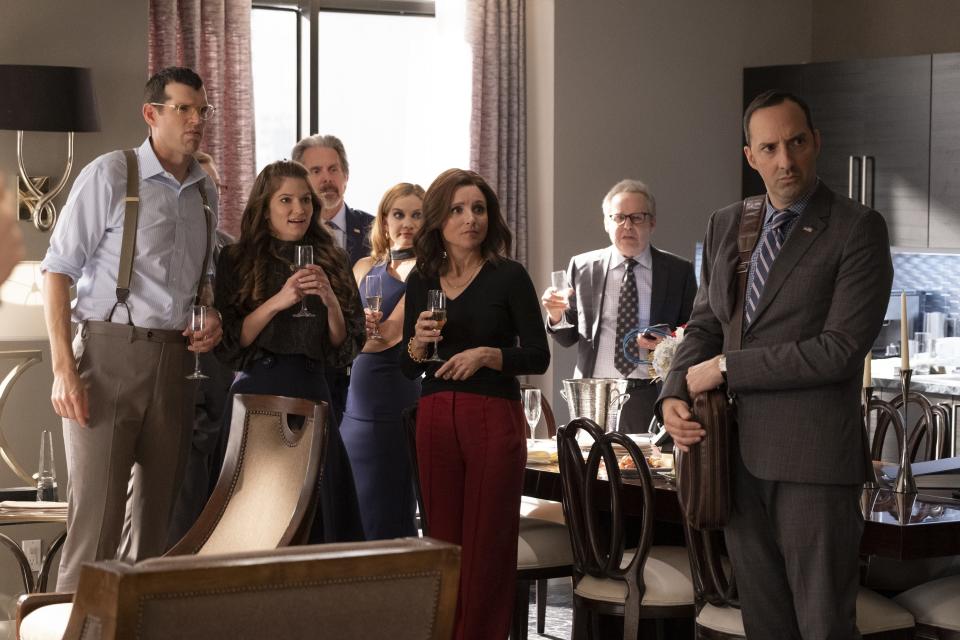
Designing the Selina Meyer–approved sets of the final season of Veep fell to production designer Jim Gloster, art director Andrew Leitch, and set decorators Kimberly Wannop and David Smith. The Oval Office, numerous five-star hotel suites, a presidential library, and ultimately Meyer’s funeral service and vault are just a few of the Emmy-nominated sets.
When it comes to production design, it’s often all about the backstory—and, in this case, costumes. Kimberly Wannop, who has been the show’s set decorator since Season Five, explains the “Oval Office was never really Selina’s design as they kept the previous Oval from the original president with the focus being on her incredible style. Jim (Gloster) kept the furniture neutral so she plays off it (with her colorful dresses such as the red she wears in the first and last episode), and everything is a little muted with the blues and creams that we used in the room.” The designers placed a “mirrored image of sofas” in front of the fireplace with a portrait of George Washington hanging above it. “Jim and I like tufted sofas, as they are not so plain and have really nice lines. I also chose curvy alabaster lamps and a cream-colored chair so Selina’s (clothes) would pop,” says the set decorator. The majority of the furnishings were purchased from Wayfair, Los Angeles vintage store Wertz Brothers, and prop houses.
For the backstory, Wannop notes that “Selina’s style is very classic, and we tried to convey she was alone in the end. The room is decorated but not all that warm and inviting because of who she is and how she is.” Set decorator David Smith, who came to the final season late in the game (Wannop was nine months’ pregnant) concurs, stating, “That is the way I felt when I first saw the set; it’s an environment to showcase her, and she does stand out. After all, she is Serena.”
Smith worked on the funeral scene and presidential library sets, along with the convention hall and skybox. “We shot the library and vault at Skirball Center and David Mendel (writer and producer) said it should look like the Reagan library,” he says. Since fashion was important to Selina, they dressed a row of mannequins in her various outfits. Says Smith, “There was an incredible red dress she wears standing in the boat of the painting of Washington crossing the Delaware, and I asked for that costume, as it made a vivid impression on me.” In the end, the satirical irony is obvious, as Wannop says, “The whole library was based on her wardrobe. That was her whole legacy.”
Originally Appeared on Architectural Digest
